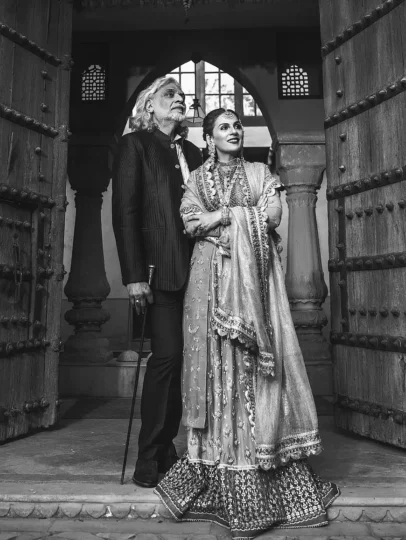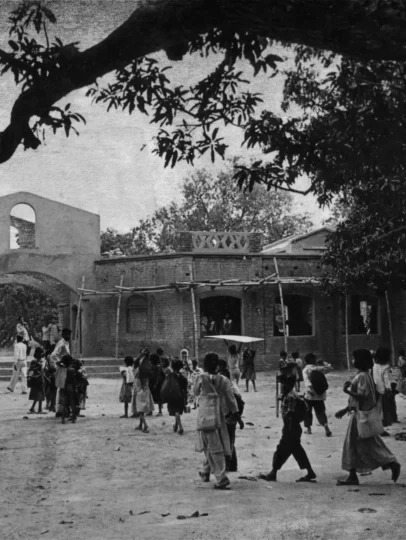The year is 1990, and storied filmmaker Muzaffar Ali has joined hands with wife Meera Ali to funnel the family’s sartorial insignia into carrying the legacy of Kotwara forward. Together, auteur and architect are staring down the barrel of reviving the dying craft of chikankari against the backdrop of a tumultuous fashion landscape that hasn’t yet reconciled with its international aspirations. A few decades later, their daughter Sama Ali would grow up to pursue her own design inclinations and eventually step into the role of creative director. However, the world has taken some chaotic trips around the sun and a pandemic has ensured that the fashion industry has been rescripted forever. The woes and wins of each generation may differ but in a candid chat with Blur The Border, mother and daughter discover that they remain unified in their quest as crusaders of craft and purveyors of art. Excerpts below:

Blur The Border (BTB): What did it mean to set up a legacy fashion house in the 1990s?
Meera Ali (MA): Back then, we didn’t think we were establishing a brand—our focus was on the purpose of the craft, skill development and generating employment opportunities. The legacy of Kotwara is something that we inherited after Muzaffar’s father passed away and we knew that we had to create something that would provide employment to the people of Kotwara. The brand has since had an organic evolution and I truly believe this is because it started with the right values and grew with the people who were a part of it. The feeling of being in something together is what made it grow in the way that we wanted it to.
BTB: Please paint us a picture of some of the struggles back then?
MA: What we were doing when we started the brand was to change the vocabulary of chikankari. In the ’70s and ’80s, the skill had really deteriorated in the hands of petty middlemen who were only looking at producing chikankari in mass volumes and selling at throwaway rates. Our main struggle was to get the craftspeople ready to upgrade their skills as they were happy doing what they were doing—a quick, dirty job for a small amount of money.
Secondly, once you skill them and bring them to that level, you have to pay them adequate rates, which means that your product becomes expensive. We then had to start teaching our patrons what it meant to buy a quality piece of craftsmanship and design, to upgrade their own understanding of what they were buying. We did this by creating a group called ‘Friends of Kotwara’, where we involved all our patrons in the process of creating this brand.
BTB: In hindsight, which of these struggles would have been easier in today's fashion industry?
MA: In the early ’90s, international fashion had not proliferated yet and there was a big disconnect between what people were designing, the market trends, the buyers’ perception and how to reach out to them. Marketing was another challenge because the only way to reach out to people was to take our print ads, which hadn’t really come of age at that time as photography wasn’t as great as it is today. Comparatively, in today’s fashion industry, it is incredibly easy to reach your audience. If you have got a good product and know how to put it out there, visibility is instantaneous because people are hungry for new content.
BTB: What would you quantify as your wins and how did you achieve them?
MA: Doing research to create a whole collection was much more difficult than what is today when you have all the resources at your fingertips. When we used to do R&D for our work, we used to scan through hundreds of books, go to libraries and visit every museum while traveling abroad to understanding the fashion landscape. However, I find that this process is more exciting because when you see something in real life, the impact is much greater than when you are researching everything on Pinterest. When you go and see the raw product and curate it yourself, you are sifting through the good, the bad and the ugly yourself in a way that will create a lasting impression in your mind forever.

BTB: How does one work on carrying forward the sartorial legacy of a name like House of Kotwara?
Sama Ali (SA): Having grown up with our karkhana on the ground floor of our ancestral home in Qaiser Bagh, my daily routine would involve coming home from school to find my parents working with the craftspeople. I would love to spend time there and watch as my ideas were transformed into embroidery for rakhis and for my dolls. Kotwara, the fashion house, was founded a year before I was born and in many ways, we grew up together. We are both symbols of the relationship my parents share with each other and it is an honour to carry forward something my parents have nurtured.
BTB: Did your parents have any words of wisdom when you took over as creative director?
SA: When I first started, I had a very pragmatic approach to the business. I was always trying to work out cost sheets before I even started working on designs and often, killing my ideas before they took root. My parents reminded me that what made us different is that we must take the design to the last mile and think of the costs later. Maybe that's the nawabi philosophy, but it's definitely the philosophy of couture. Design is paramount, it should always be your primary motivation if you are to find pride in your work.
BTB: What would you quantify as your wins and how did you achieve them?
SA: For me, it is the little wins that keep me going. When I make a couture piece for someone's special day and they see it for the first time, the feeling that I’ve exceeded someone's expectations and given them joy is what fuels me to work harder. If we focus only on the big wins, we run the risk of missing the smaller moments of joy that can make the journey so much sweeter.
BTB: What are some values that you have in common with the previous generation?
SA: Concern. This concern flows through my veins for my craftspeople, for my patrons and for the fact that I want to add something of beauty to the world around me. If I were to hand over the brand to the next generation someday, perhaps my only advice would be to stay rooted, remember where we came from and to be compassionate in how much they take my legacy forward.
BTB: How do you see the borders blurring between the generations?
MA: Kotwara is a legacy not just as a fashion brand someone started in 1990, but because it is a concept and a history of over a thousand years. For us, it is very important that the brand is not known as Muzaffar Ali, Meera Ali, or today, as Sama Ali. We are not just one person, but a collective psyche of the people of Kotwara. This is a crucial legacy that we have established and one which Sama can take forward on the shoulders of the people who have stood with us. The world of fashion may have changed, the people wearing it may have changed but if you can find ways to reach them while keeping your core values intact, it is going to be a fantastic journey ahead.